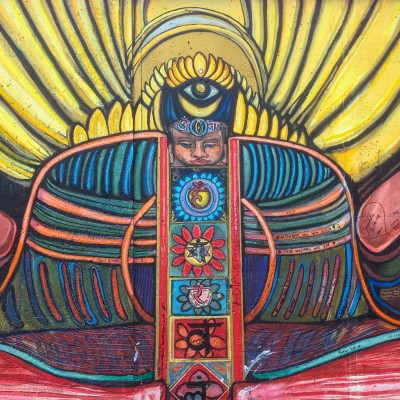Engaged Jain Art
Back To Blogs


Engaged Jain Art
Narendra Kumar Jain’s Seven Stages of Enlightenment on the Berlin Wall
09/23/2025
“The artistic language is an ineffable language, which many intellectuals do not even understand.”
Among the many murals at Berlin’s East Side Gallery which offer commentary on the fall of the Wall and the global desire for political freedom, I have always been struck by Narendra Kumar Jain’s The Seven Stages of Enlightenment (German: Die sieben Stufen der Erleuchtung). Drawing from an online archive of interviews and images, I have written an entire chapter about this one mural in our volume Engaged Jainism: Critical and Constructive Studies of Jain Social Engagement (Miller and Bohanec 2025). Here I will tell you a bit about Jain’s mural and give a preview of what I write about in that chapter.
Rather than foregrounding protest, Jain’s mural invites contemplation. A meditative red figure, centered and composed, is framed by ascending cakras symbolizing the inner journey toward liberation. Painted in 1989 and 1990, shortly before and then after the Wall’s fall, the mural introduces a profound ethical and spiritual perspective drawn from India’s cultural traditions to one of the world’s most politically charged canvases. Jain’s work links India’s ideals of spiritual liberation with Berlin’s post-Cold War reimagining of freedom. It stands as an assertion that true freedom includes both liberation from state oppression and also liberation from inner bondage rooted in ignorance and attachment.
Narendra Kumar Jain was born in Delhi in 1937 and raised within the Jain tradition, an Indian religious system rooted in the principles of ahiṃsā (nonviolence), spiritual discipline, and liberation from karmic entanglement. Jain became not a public intellectual or celebrity artist, but a yoga teacher, an art historian, and a practitioner of devotional visual expression. In 1967, he moved to Berlin to study art history, at a time when Jainism was virtually unknown in Europe. When the Berlin Wall fell in 1989 and the East Side Gallery was conceived as an international site of artistic response, Jain faced a critical challenge: how to communicate the moral and spiritual depth of Jainism to a Western audience unfamiliar with its concepts. The solution required not only cultural fluency but artistic creativity.
Rather than translating the Jain tradition through literal or textual means, Jain opted for a symbolic visual strategy that could resonate globally. He represented the path to spiritual liberation through the seven cakras, widely recognized symbols of energy centers in Indian yogic and tantric systems. While not a part of Jainism per se, the cakras allowed Jain to articulate a shared Indic understanding of spiritual ascent, discipline, and liberation that had been essentialized in the crucible of India’s colonial and romantic orientalist encounters.
The central figure in lotus posture exudes stillness and interiority. Each cakra marks an increasingly subtle progression from the material to the spiritual: earth, water, fire, air, space, intuition, and transcendence. The visual movement is vertical, while two hands in a meditative jñāna-mudrā extend horizontally in perfect balance. This compositional decision reflects the conviction that freedom, at least from a yogic perspective, is cultivated through an internal, upward transformation that collapses binaries such as us/them, and even east/west.
Jain offered an accessible yet profound visual distillation of a modern form of Indian yoga as an invitation, not an imposition. In doing so, he reframed the narrative of the Wall symbolizing external struggle to also include emphasis on internal mastery. The mural’s upward visual logic parallels both the Jain path of mokṣa (liberation) and Berlin’s own aspiration to heal and reunify east and west. Just as Jainism calls its practitioners to transcend attachment and violence through ethical purification, Berlin in the 1990s faced the moral task of rebuilding a city without repeating cycles of violence, exclusion, and domination. Thus, Jain’s mural becomes a spiritual and political allegory. It reframes liberation not as a historic event, but as an ongoing task.
The East Side Gallery features other artistic responses from around the world: depictions of geopolitical strife, social injustice, and cultural resilience. Many of these murals operate within a visual lexicon of protest: raised fists, barbed wire, national flags, fractured maps. Jain’s mural introduces an alternative model of liberation that is not just reactive, but also simultaneously reflective; not just oppositional, but also aspirational. Its power derives from these contrasts. While other artists document historical wounds, Jain proposes a method for healing and transcending them. His mural functions not as commentary but as prescription: it offers a path out of violence through restraint, awareness, and disciplined compassion.
Jain’s contribution is not incidental. It asserts that spiritual traditions such as yoga but also his own tradition of Jainism, long marginalized in global discourse, might have urgent relevance in conversations about freedom, responsibility, and world peace. In a world increasingly defined by ecological crises, political polarization, and social injustice, Jain’s mural holds renewed relevance today.
Narendra Kumar Jain’s Seven Stages of Enlightenment is thus more than a mural, it is a visual treatise on a universal vision of freedom that had, no doubt, been drawn from medieval yoga and tantric traditions that had been canonized in the crucible of India's colonial encounters. It reminds us that the dismantling of political walls must be accompanied by the dismantling of internal walls such as ignorance, anger, consumption, and cruelty.
Jain did not simply bring Indian aesthetics to a German landmark; he brought Jain and yoga ethics to a global conversation about liberation. In doing so, he demonstrated that ancient spiritual traditions - however reshaped they had already been during India's colonial period - still have an urgent message for global society. In this way, he was, along with a number of other Indian muralists, following the lead of Mexican Muralism, which sought to visually convey basic truths and a just vision of the future to a seemingly illiterate public. Jain’s mural is thus not only an artifact of the past, but, like those of Mexican Muralism, a living ethical intervention in the present. It is a voice tucked away at Berlin's East Side Gallery offering a quiet, though important call to look inward, to rise upward, and to live with greater compassion in a still-divided world.
If you share these concerns and wish to explore creative solutions to some of society’s most pressing social challenges, join the online Engaged Jain Studies graduate program where you will be supported by expert faculty in the field of Engaged Jain Studies.
🖼: East-Side-Gallery, Berlin. Ausschnitt aus dem Bild: Sieben Stufen der Erleuchtung von Narenda Kumar Jain.
Engaged Jainism: Critical and Constructive Studies of Jain Social Engagement is available for pre-order from SUNY Press.
Christopher Jain Miller, is the co-founder, Vice President of Academic Affairs, and Professor of Jain and Yoga Studies at Arihanta Institute. He completed his PhD in the study of Religion at the University of California, Davis and is also a Visiting Researcher at the University of Zürich's Asien-Orient-Institut and Adjunct Professor at Claremont School of Theology where he co-developed and co-runs the fully-online MA-Engaged Jain Studies graduate program.
